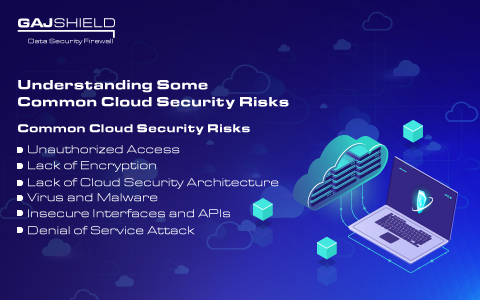Understanding Some Common Cloud Security Risks.
With the onset of digital transformation, cloud migration has been a big trend and regularly used by organizations in recent times. Data, applications, assets, and other business elements are transferred from an on-premises environment to a cloud computing environment. However, like many digital revolutions and their surge, the need for cloud security arose with the rise in cybercrime. Cloud security refers to the measures taken to protect data, applications, and the associated infrastructure of cloud computing. It is designed to secure the cloud from various cyber threats, such as data breaches, malware attacks, and hacking.
As organizations move toward enhancing their operational approach while embracing these new technologies, challenges arise when maintaining productivity and security. Transitioning to a cloud or hybrid cloud-based ecosystem can lead to many threats if not secured accurately. Therefore, enterprises need to be aware of cloud security risks to protect their data security by deploying the correct measures.

Common Cloud Security Risks
To optimally protect an organization’s data stored in the cloud, they need to be aware of its security risks and take appropriate actions.
1. Unauthorized Access
Data stored in the cloud can be vulnerable to unauthorized access or theft. This can occur due to cloud misconfiguration, weak passwords, unauthorized access to accounts, or through malware or other cyber threats. Zero trust and least privilege access should be employed to protect organizations from unauthorized access theft. The adoption of both these security measures for the mitigation of cyber threats arising from identity access management can help provide optimum data security measures to a company. It will provide data access authorization only after verifying the user's identity.
2. Lack of Encryption
If data is not encrypted and is accessed by an unauthorized individual, it could be compromised or stolen. Encrypting data in the cloud helps protect the information's confidentiality, ensuring that authorized individuals can only access it. Therefore, encrypting data in the cloud helps to enhance the overall security of an organization's data and systems. It is a crucial component of a comprehensive security strategy.
3. Lack of Cloud Security Architecture
Various enterprises start integrating the cloud into their systems without developing a proper architecture. This makes it vulnerable to cyber threats and attacks, leading to potential financial and reputational loss. Therefore, companies must understand the various cybersecurity risks they may face before implementing the cloud. To ensure that the cloud integration is successful and secure, the security infrastructure must align with the organization’s goals. Additionally, continuous monitoring should be enforced and ensure that the policies, standards, and controls are updated to remain relevant.
4. Virus and Malware
Malware and viruses can infect cloud-based systems and applications, just like on-premises systems. These threats can compromise the security of an organization's data and systems and can spread quickly through a network. It is crucial for organizations to implement measures to prevent malware and viruses, such as installing antivirus software and regularly updating and patching systems.
5. Insecure Interfaces and APIs
Interfaces and APIs (Application Programming Interfaces) are used to access cloud-based systems and data. If these are not properly secured, they can be vulnerable to attack. To protect against this risk, organizations should ensure that their interfaces and APIs are properly configured, and that access is restricted to authorized users. APIs should be designed, developed, and tested according to industry standards to maximize security. Additionally, data tampering and disclosure can be prevented by separating audit tools used to interact with the organization’s information system.
6. Denial of Service Attack
A DoS attack is a type of cyber-attack designed to make a system or network unavailable to users. These attacks can be launched against cloud-based systems, disrupting operations, and damaging an organization's reputation. To protect against DoS attacks, organizations can use cloud based WAF (web application firewall), which provides an additional layer of protection against DoS attacks by analyzing traffic patterns and identifying suspicious activity. Also, implementing load balancing helps to distribute traffic across multiple servers, which can help to prevent a single server from becoming overwhelmed during a DoS attack. Organizations need to have a plan in place for responding to a DoS attack. This can include activating additional server capacity, redirecting traffic to backup servers, and working with the cloud provider to implement additional security measures.
With cloud computing, organizations have seen various benefits in terms of scalability, cost savings, flexibility, and more. However, before integrating and making use of the cloud, organizations need to be wary of all the risks that may come with it and enhance their cloud security to maintain optimum data security and protection. Several common cloud security risks are often overlooked, leaving an organization’s system vulnerable to cyber-attacks. Therefore, sufficient, and continuous security is required to protect an organization’s digital assets and more.
GajShield provides its users with robust cybersecurity services such as data encryption, data leak prevention, multi-cloud security, and many more, making it an all-rounded data security solution. Contact us to learn more about our enhanced security solutions.
Get In Touch With Us
Subscribe to our Newsletter
2025 © GajShield Infotech (I) Pvt. Ltd. All rights reserved.
